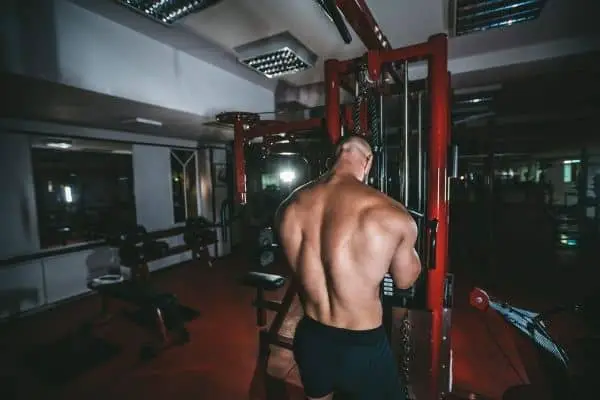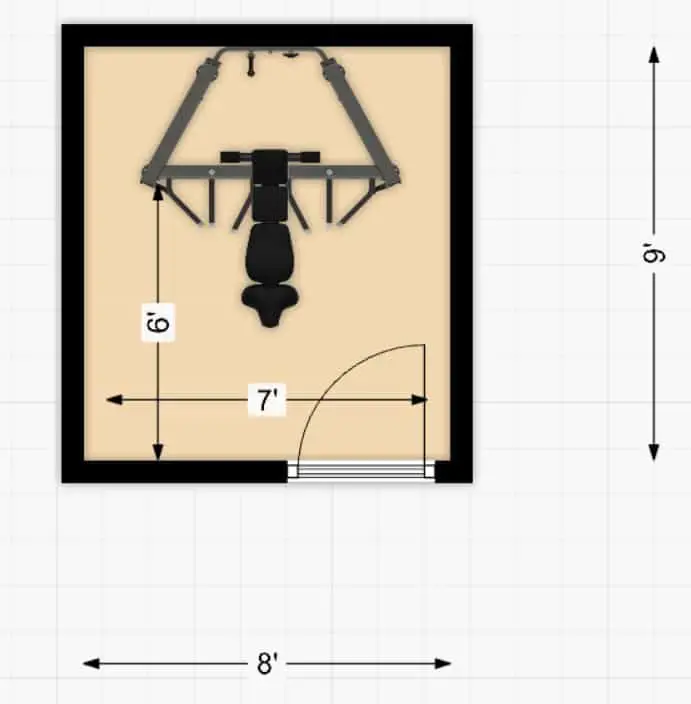A functional trainer is one of the most versatile pieces of workout equipment you can buy. But how big are they and how much floor space do you need to properly use it? I’ve put a lot of data together and here’s what you want to know.
The average functional cable trainer has a foot print of 65.1” x 49.7”. For this size trainer, a free space that measures 8’ x 9’ is necessary to perform all the exercise options a functional trainer offers. For more compact functional trainers 8’ x 8’ is suitable.
Of course not every functional trainer is the same. In fact there are pretty big differences. Find the dimensions of many popular models below and how you can figure out how much space is necessary.
Looking for a good functional trainer for your home gym? Click here to find which one I recommend.
Contents
Functional Trainer Dimensions
Below you can find a list of the most popular functional trainers on the market. There aren’t any strict rules about what can be called a functional trainer although you’ll recognize one when you see one. Click here to find an example.
Basically a functional trainer is a smaller version of a cable crossover. A functional trainer has two weight stacks attached to two cables that are height adjustable through a system of pulleys. The two weight stacks are placed at an angle so the whole machine has a kind of V shape. The pulleys are usually about 40” to 70” apart.
A cable crossover usually has the pulleys opposite each other and further apart so it takes up much more space and is pretty rare in home gyms. A functional trainer packs all that functionality and more in a smaller package.
But how small exactly? Take a look at the dimensions below.
| Brand | Model | Height (inch) | Width (inch) | Depth (inch) |
|---|---|---|---|---|
| Bodycraft | XFT | 83 | 50 | 61 |
| Bodycraft | HFT | 82 | 55 | 40 |
| Bodycraft | HFT Pro | 82 | 55 | 40 |
| Bodycraft | PFT | 82 | 52 | 39 |
| Bodycraft | RFT | 83.2 | 59 | 65 |
| Bodycraft | Jones Platinum | 83.5 | 84.5 | 74 |
| Body Solid | PFT100 | 83 | 63 | 42 |
| Body Solid | S2FT | 99 | 79 | 54 |
| Body Solid | BFFT10R | 84 | 61 | 55 |
| Body Solid | GDCC200 | 84 | 73 | 43 |
| Body Solid | GDCC210 | 84 | 58 | 43 |
| Body Solid | SDC2000G-2 | 91 | 46 | 44 |
| Life Fitness | G7 Home Gym | 83 | 69.5 | 48.5 |
| Life Fitness | Signature Dual Pulley | 94 | 62 | 45 |
| Precor | FTS Glide | 85 | 48 | 53 |
| Reeplex | Commercial Dual Arm | 82.7 | 85 | 51 |
| Reeplex | CX2 | 90.5 | 78.3 | 70 |
| TuffStuff | PPMS-245 | 86 | 127 | 61 |
| TuffStuff | PPMS-255 | 90 | 73 | 40 |
| Hoist | MI5 | 83.5 | 52.6 | 51 |
| Hoist | MI6 | 83 | 54 | 37.75 |
| Hoist | MI7 | 83.5 | 60.36 | 60.36 |
| Pivot Fitness | Functional Trainer HM3360 | 83.5 | 66.15 | 31.9 |
| Pivot Fitness | Cable Smith Machine FSR400 | 85.8 | 76.4 | 55 |
| Inspire Fitness | FTX | 85 | 54 | 40 |
| Inspire Fitness | FT1 | 83 | 54 | 46 |
| Inspire Fitness | FT2 | 88 | 61 | 58 |
| Xmark | XM-7626 | 83 | 65 | 43.5 |
| Average | 85.4 | 65.1 | 49.7 | |
| Min | 82 | 46 | 31.9 | |
| Max | 99 | 127 | 74 |
The average functional trainer has a foot print of 65.1” by 49.7”. The widths range from 46” to 127” while the depths range from 31.9 to 74”.
There are very big differences in dimensions between the models because there are quite a few different designs out there that just do things a little differently although their functionality is similar. Some models double as a Smith machine and therefore have a built in barbell. Barbells tend to be quite a bit wider than the average functional trainer.
Suggested: Best cardio machine to use under low ceilings
The widest machine is the TuffStuff PPMS-245. This machine is also quite a bit different than average. Instead of two stationary pillars, it has arms that come out of the middle of the machine. Those arms are adjustable in height and different angles and the widest it can be is 127 inches.
Depths differ a little less but it’s still a pretty big range. Here design differences also have a pretty big impact. The majority of the traditional functional trainers is between 40” and 60” deep.
Heights of functional trainers are pretty consistent and range from 82” to 99” with an average of 85.4”. The heights differ less because most people have to fit under it without hitting their head on the pull up bar. At the same time it shouldn’t be taller than the average ceiling.
How much floor space does a functional trainer need?

Every machine is different and has a different foot print. Luckily they all have roughly the same functionality so there are some guidelines you can follow to figure out how much space you need for your specific model.
An average functional trainer needs a room that’s about 9’ x 8’ big. This allows enough room to place the machine and use it properly. For compact machines a space of 8’ x 8’ is suitable.
There are a few positions to put your body in you should have space for to be able to do all the exercises a functional trainer has to offer. Let’s look at three areas around a functional trainer and how much space you need there. Below you can find the minimum amount of space. More space than recommended is comfortable though.
Suggested: How heavy is a functional trainer? Safe to use in an apartment?
Behind
Behind a functional trainer, you don’t need much space. There is no exercise you can do there that can’t be done anywhere else. As long as the machine doesn’t touch the wall it’s OK.
Inside
Between the pulleys to the back of the machine should be kept free of any other things of course. You might want to place a bench there or put some cable attachments on the floor and that’s fine. Just don’t put anything permanent there.
Suggested: How much does a functional trainer cost?

Sides
Again, directly next to a functional trainer you don’t need much space. While you could stand next to the machine and pull the cable, you can do exactly the same thing in front/within the machine. Because there are pulleys on two sides, there is no need to go off to one side.
One thing to keep in mind is that the pulleys and all other parts do have to be able to move freely. Keep at about half a foot free next to the widest part of the trainer.
Some functional trainers have a built in barbell. IF that’s the case, the barbell is often plate loaded. That means you need enough room to maneuver on the sides to load and unload weight plates on the barbell. For those machines, you want to keep at least 2 feet of free space on both sides.
Machines that have long arms instead of pillars will usually tell you the width of the machine with both arms in the widest and deepest position. Use that dimension and add about a foot to allow for the pulleys to swing around freely. Yes, that means this type of machine does need a lot of space.
Front
In the front of a functional trainer is where all the action happens. You want to keep a rectangle of space free in front of the cable gym for that reason. How big should that rectangle be? Pretty big;
The rectangle should be at least 5’ preferably 6’ deep from the front of the machine (measured from the pulleys). This allows you to place a bench in the trainer and lie down on it while not hitting the wall with your knees.
Suggested: Functional trainer with highest resistance
The rectangle of free space should be at least 7’ wide so it extends a little wider than the trainer. 7’ wide is good for the average functional trainer although 8’ will feel a little less claustrophobic. If yours is wider or narrower than average, add about 1 foot on both sides to the width of your specific machine. That will give you enough width to feel comfortable in most positions.
I can understand if that’s not really clear so take a look at the floor plan below. That will explain it much better.

The dimensions of the functional trainer used in that floor plan are the averages of the list above. That means most functional trainers can be used properly in a space of about 8’ by 9’. For more compact machines 8’x 8’ is suitable.
The good news is, you can use this rectangle of free space for other exercises when not using the functional trainer. It’s big enough to use a barbell, dumbbells, kettlebells and more and also provides enough room for bodyweight exercises.
My favorite compact functional trainer is the BodyCraft HFT. It’s very well built, has a small foot print that measures only 40″ x 55″ and has great warranty conditions. Check it out below.
Corner placement
Some functional trainers are designed to be placed in a corner. The angle between the two pillars is 90 degrees so it fits in a normal corner.
In that case, it’s probably quite difficult to get an exactly rectangular free space. Just make sure you’ve got a free space that extends 5’ to 6’ from the front of the machine and is at least the same width as the machine.
Best Cable Machine Accessories
Make your cable trainer experience even better with these accessories.
- Attachments: No cable machine is complete with a good set of attachments. Click here to find the best set of attachments
- PlateMate: One or two platemates (Amazon link) can help you increase the weight more gradually on your weight stack. Just stick them onto your weight stack.
- Bench: A good adjustable weightlifting bench like the CAP Deluxe (Amazon) adds many exercise options to a cable machine like bench presses and shoulder presses.
Find the most complete functional trainer that includes most of these accessories by clicking here.

